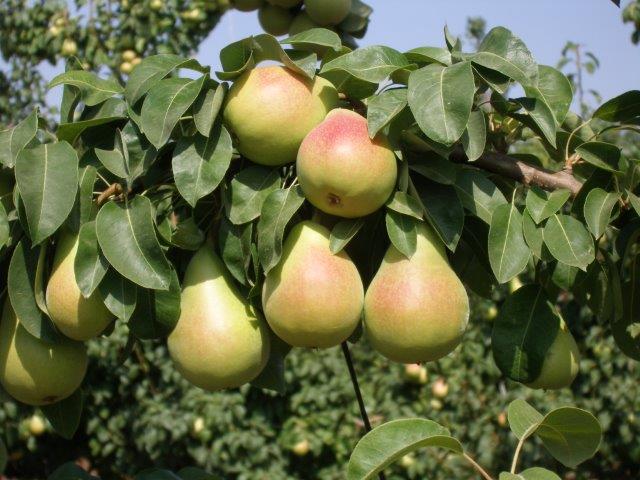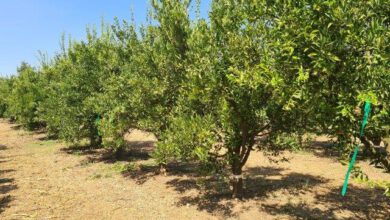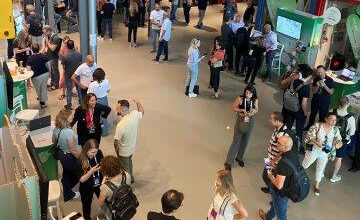Raphael A.Stern (raffi@migal.org.il) , Israel Doron
North Research and Development Station – MIGAL*
Introduction
‘Spadona’ is the central and most important pear cultivar (cultivated variety) in Israel today. Of 15,000 dunams of pear orchards in Israel producing ca.25-30,000 tons of pear fruit per year, the ‘Spadona’ cultivar amounts to two thirds (2/3) of the total planted area. Despite its relative success in the fruit market, this variety suffers from crop yield instability and from a medium quality, and most of all from small-sized fruit. From experimentswe have carried out and from visits in Spain, we have learned that in order to get a high fruit yield with larger-sized fruits, it is important to strengthen the trees. Following ten years of work, implementing the Spanish method, trees with a too strongvegetative growth patternwere received,due to their rooting above the grafting area, which results in an increase in the volume of the trees.
As a result of the excess growth, which brings about too large trees, many work days are needed to prune them, to anchor them to pickets, in shaping them and, needless to add, in picking the fruits. In addition, the overgrowth of the trees brings about a higher susceptibility of the trees to attacks by the bacterium Erwinia Amylovora, which causes the pear fire blight disease.
The aim of this study was to develop new shaping methods, which will bring about a compact ‘Spadona’ tree and thus will lower tree rearing expenses. The study began in the summer of 2011and ended in 2022.
Materials and Methods
In the summer of 2011, a pear tree plot, consisting of two commercial cultivars, ‘SPADONA’ as a principal cultivar and ‘COSCIA’ as a pollinating cultivar, were planted in the orchard farm. A few new shaping methods, denser than the accepted standard today, were examined – 4.5X2.0 meters(110 trees/dunam), which was planted as an axis, and was used as a commercial control.
These are the new shaping methods examined:
1. ‘AXIS’, 3.5X1.5 meters (190 trees/dunam) – an easy-to-erect and relatively cheap – to -carry out method;
2. A ‘DENSE AXIS’, 3.5X1.0 meters (286 trees/dunam) – an easy-to-erect and not expensive method, but much denser in terms of trees per land unit;
3. ‘V SHAPING’, 3.5X0.5meters (570 trees/dunam) – higher erection expenses, but a higher yield potential with larger fruits;
In each of the shaping methods, two rootstocks for the ‘SPADONA’ cultivar were tested:
quince A as a standard, and a quince rootstock BA-29. Each rootstock and each shaping method were tested in three planting depth grades (a grafting 10 cm. above ground level, at ground level and 10 cm. below ground level).
The experimentdesignwas the following: Random blocks, four replicates, and a varying tree number in each replicate, in accordance with the planting distances. The ‘COSCIA’ trees, used mainly for pollination, were planted on BA-29 rootstock, in a unified depth of 10 cm. and in using the ‘AXIS’ method (3.5X1.5 meters), or using the ‘DENSE AXIS’method(3.5X1.0 meters).
The Main Results
Trunk Circumference: the more the tree density (number of trees per land unit) rises, so is the tree’s growth more restrained, e.g., a lesser tree circumference and a morefruit yield per dunam and alarger fruit size per dunam. The best result was achieved in the ‘V’ shape, with 570 trees per dunam.

Figure 1: The Influence of Shaping Methods with the Quince A Rootstock on Trunk Circumferences (4/2011-12/2022).
Different letters at each sampling date denote a statistically significant difference between the treatments, at P=0.05, according to Duncan’s test.
The A rootstock and the highly-dense ‘V’ shaping method, resulted in the best totalfruit yield and a large fruit yield per dunam (Tables 1 and 2).
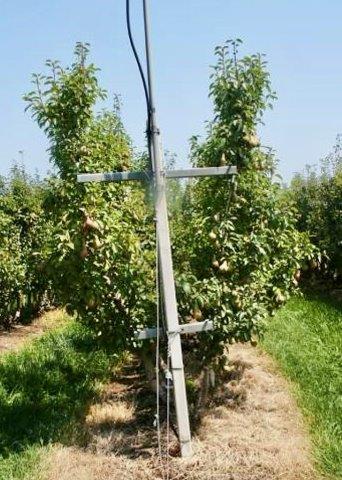
A photograph showing a typical ‘V’ shaping of a ‘Spadona’ pear tree, grafted on a quince A rootstock.

Table 1: The Influence of the Rootstock and the Shaping method on the accumulated totalyield (2015-2022) per dunam (ton/dunam) of ‘SPADONA’ trees, summer 2022.
Results in the same column accompanied by different lower-case letters (difference between the rootstocks) and results in the same line accompanied by upper-case letters (difference between shaping methods) – are statisticallydifferent at a significance level of P<0.05, according to Duncan’s test.
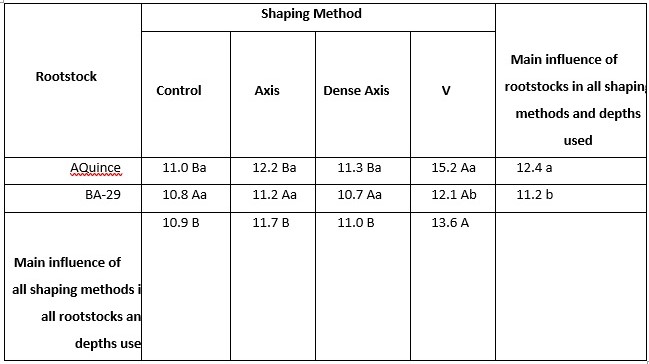
Table 2: The Influence of the Rootstock and the Shaping method on the accumulated large fruit (>60 cm)yield (2015-2022) per dunam (ton/dunam) of ‘SPADONA’ trees, summer 2022.
Results in the same column accompanied by different lower-case letters (differences between rootstocks)and results in the same line accompanied by different upper-case letters (differences between shaping methods),are statistically different one from another at a significance level of P<0.05, according to Duncan’s test.
Rootstock Planting Depth: a ‘high’ graft, of 10 cm.above ground level, brought about the best result, in terms of a totalyield and a larger fruit size yield per dunam.
Conclutions
The assumption, according to whichrestrained pear tree integrating the above-mentioned three methods (planting density, rootstock and planting depth), in order to balance properly between growth (vegetation) and fertility (productivity), was verified. At this stage it seems that planting using the ‘high’ grafting method, slows down the growth vigor, when raising the planting density and implementing the quince A ‘weak’ rootstock, it is possible to achieve the required optimal balance between growth (vegetation) and fertility (productivity), and thus reach a maximal yield per dunam of a large-in-size fruit yield.
Plans For the Future
An on-going survey, with the aim of following pear trees’ yields in the following few years, with the aim of clarifying whether under local climatic conditions (extremely hot in the summer months), it is still possible to plant ‘SPADONA’ trees with the rootstock above the ground. If it will be found that this planting method is too hazardous, it will be better, perhaps, to plant at ground level or lower than that.
Acknowledgments:
We would like to thank Galit Redel for the technical assistance and Nurit Bar Sinai for the
Statistical analysis.
*Migal, P.O.B 831 KIRYAT SHEMONA, ISRAEL

